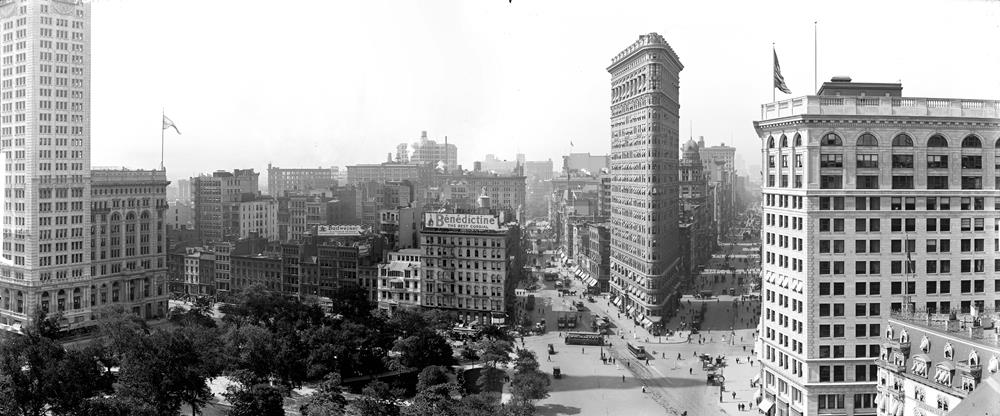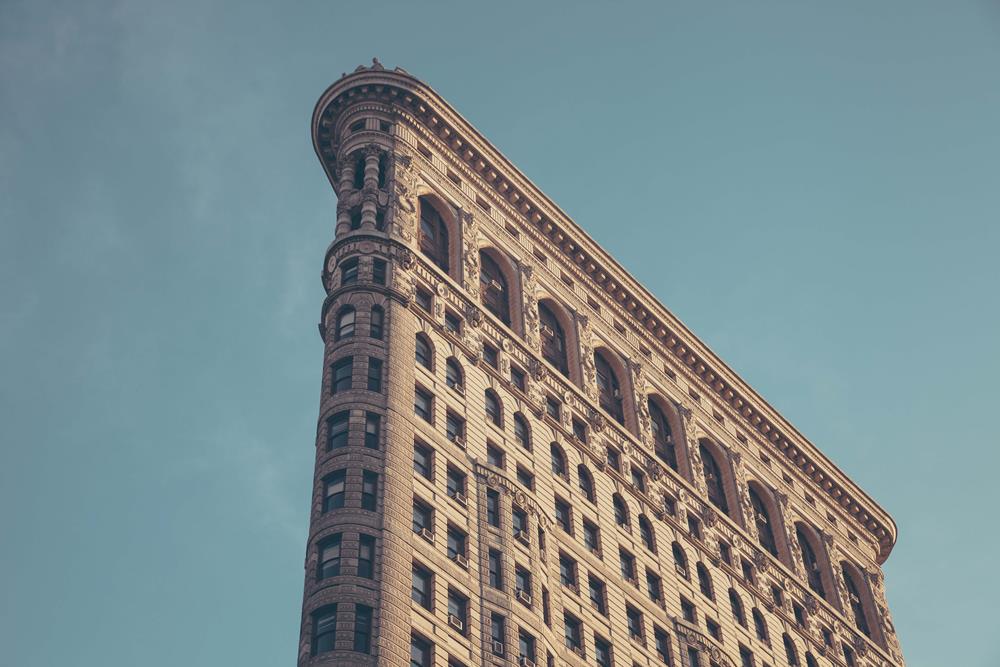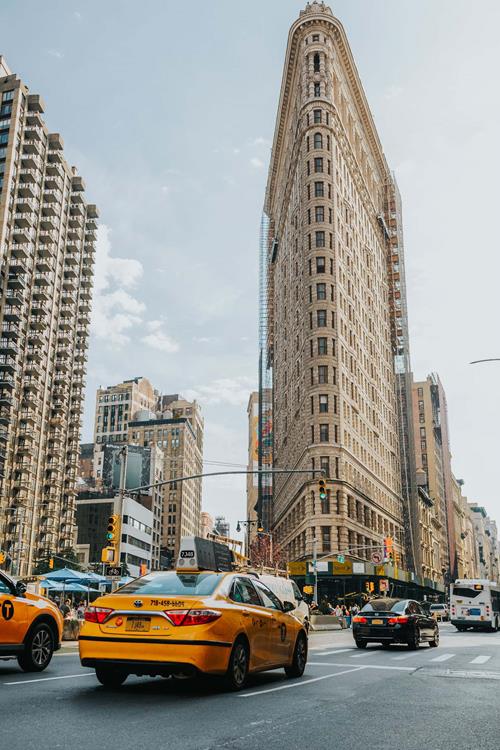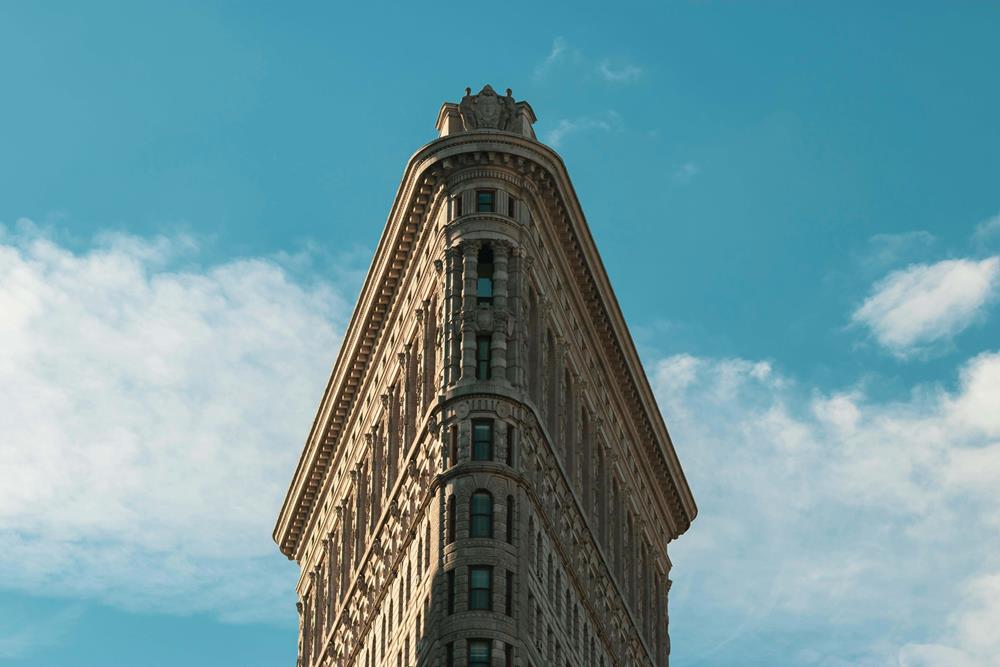The Flatiron Building is one of New York City’s most iconic landmarks, renowned for its distinctive triangular shape and storied past. Nestled at the intersection of Broadway, Fifth Avenue, and East 22nd Street, this architectural marvel has captured the imagination of artists, photographers, and historians alike since its completion in 1902.
Historical Context and Construction
To explore the history of the Flatiron Building through different eras, we can divide its story into several key periods: the Early 20th Century following its construction, the Mid-20th Century as it adapted to changes, and the Late 20th Century to the present as it became a historic landmark and symbol of New York’s architectural heritage.
Early 20th Century – The Dawn of a Skyscraper
Construction and Early Years (1902-1920s)
The Flatiron Building was completed in 1902, amidst a rapidly evolving New York City skyline. This era was marked by technological innovation and urban expansion, with the Flatiron leading the architectural charge as one of the tallest buildings of its time. Its unique shape and Beaux-Arts style made it an instant landmark. The building housed numerous offices, including those of publishing and architectural firms, reflecting the economic boom of the period. The surrounding Flatiron District became a commercial hub, with the building at its core contributing to the area’s vibrancy and growth.
Mid-20th Century – Adapting to Change
The Great Depression and War Years (1930s-1940s)
The economic downturn of the Great Depression affected businesses within the Flatiron Building, mirroring the wider struggles of the city and country. However, the building remained a steadfast symbol of New York’s resilience. During World War II, the Flatiron Building, like much of New York, was subdued, with its offices playing roles in war-related industries and efforts.
Post-War Boom and Modernization (1950s-1970s)
The post-war era brought prosperity and modernization to New York City. The Flatiron Building saw internal renovations to modernize its facilities and accommodate the changing needs of its tenants. The surrounding Flatiron District began to experience shifts as well, with the emergence of new architectural styles and the redevelopment of older buildings, reflecting broader trends in urban renewal and change.
Late 20th Century to Present
Historical Landmark Designation (1980s-1990s)
In 1989, the Flatiron Building was designated a New York City Landmark, cementing its status as an integral piece of the city’s architectural and cultural history. This recognition was part of a broader movement to preserve historic structures throughout New York City. The building also became a National Historic Landmark, highlighting its significance not just to New York, but to the nation’s architectural heritage.
Throughout these eras, the Flatiron Building has remained a constant in the ever-changing landscape of New York City, embodying the city’s architectural ambition, resilience, and capacity for reinvention. Its story is not just about bricks and mortar but about the spirit of a city that continues to evolve while honoring its past.
Architectural Marvel and Design Innovations
Background on the Architect – Daniel Burnham
Daniel Burnham was not just an architect; he was a visionary who played a pivotal role in shaping the urban landscape of America. Known for his adherence to the philosophy “make no little plans,” Burnham’s ambitions for the Flatiron Building were anything but modest. His design ethos, heavily influenced by the Beaux-Arts movement, emphasized grandeur, symmetry, and a harmonious blend of classical architectural elements with modern engineering. Burnham envisioned the Flatiron Building as a testament to New York City’s burgeoning status on the world stage, a structure that would not only stand out for its height but also for its artistic architectural expression.
The Building’s Distinctive Triangular Shape
The Flatiron Building’s iconic triangular shape is a direct result of the peculiar wedge-shaped block at the intersection of Broadway, Fifth Avenue, and East 22nd Street. Rather than seeing this irregular plot as a limitation, Burnham seized it as an opportunity to create something unique. The building’s shape, reminiscent of a clothes iron, not only gave it its name but also turned it into a visual spectacle. This innovative use of space challenged the conventional rectangular forms of the time and demonstrated that architectural beauty could arise from adapting to the urban grid’s constraints.
Exploration of the Innovative Steel-Frame Construction
The Flatiron Building was one of the early adopters of steel-frame construction, a method that would become a staple in skyscraper design. This technology allowed for much taller structures than was previously possible with traditional masonry, opening up new possibilities in architecture. The steel skeleton provided the necessary support to accommodate the building’s soaring height without compromising on floor space or window size. This construction method was not only revolutionary for its time but also symbolized the dawn of the modern era in architecture, where the sky was literally the limit.
The Beaux-Arts Architectural Style
The Beaux-Arts style, originating from the École des Beaux-Arts in France, is characterized by its grandiose and elaborate designs, often incorporating classical Greek and Roman elements. The Flatiron Building’s facade is a celebration of this style, with its intricate limestone detailing, terra cotta panels, and ornate, sculptural decorations. Each floor is marked by different classical motifs, and the crown of the building is adorned with a heavy, elaborate cornice. The use of horizontal and vertical lines creates a sense of rhythm and balance, while the large windows, framed by ornamental surrounds, allow for an abundance of natural light, making the interior spaces as remarkable as the exterior. This blend of classical beauty and modern function is what makes the Flatiron Building a quintessential example of Beaux-Arts architecture and a jewel in New York City’s architectural crown.
Conquering the Challenges – Building the Iconic Flatiron
The construction of the Flatiron Building faced several challenges, characteristic of early 20th-century skyscraper development in a bustling urban center like New York City. These challenges were not only technical but also related to the building’s unique design and the public’s reaction to such an innovative structure.
- Unique Triangular Plot: The most distinctive challenge was the building’s triangular plot, formed by the intersection of Broadway, Fifth Avenue, and 22nd Street. This unusual shape required a novel architectural approach to make efficient use of the limited and irregular space, leading to its iconic flatiron-like design. The challenge was to create a functional office building on a plot that was far from the conventional rectangular shape typical of most buildings of the era.
- Innovative Steel-Frame Construction: The Flatiron Building was one of the first skyscrapers to utilize a steel-frame construction method, allowing it to reach a height of 285 feet (about 87 meters) with 22 floors. This construction technique was relatively new at the time and posed challenges in terms of both design and execution. Ensuring the stability and safety of such a tall structure on a narrow plot required careful planning and innovative engineering solutions.
- Wind Tunnel Effect: The building’s height and shape created a wind tunnel effect on 23rd Street, which was particularly pronounced due to the lack of surrounding tall buildings at the time. Pedestrians sometimes struggled against gusts channeled around the building, leading to the installation of special sidewalk canopies to protect them from falling debris exacerbated by the wind.
- Public and Media Reaction: The Flatiron Building also faced challenges in public perception. Its towering presence and unconventional shape were subjects of both awe and ridicule. Some critics and observers were concerned that the building could collapse due to its height and slender base, while others mocked its unique appearance. However, over time, these criticisms faded as the building became an accepted and celebrated part of New York City’s skyline.
- Construction Techniques and Material Availability: The early 1900s construction techniques and the availability of materials presented their own set of challenges. The reliance on horse-drawn vehicles for transporting construction materials and the lack of modern construction equipment required innovative solutions and careful logistical planning to ensure the timely and efficient completion of the building.
Despite these challenges, the Flatiron Building was completed in 1902 and quickly became an architectural icon and a beloved landmark in New York City. Its successful construction amid numerous challenges showcased the ingenuity and ambition of early skyscraper architecture and paved the way for future developments in urban construction and design.
Cultural Impact and Artistic Inspiration
Depictions in Art, Photography, and Popular Culture
The Flatiron Building has been a muse for artists and photographers since its completion, captivating onlookers with its striking form and presence. Its unique triangular shape and Beaux-Arts detailing have made it a subject of fascination and a symbol of New York City’s architectural innovation.
- Photography: Early 20th-century photographers like Alfred Stieglitz were drawn to the Flatiron Building, using it to explore themes of modernity and urban life. Stieglitz’s famous 1903 photograph, “The Flatiron,” portrays the building as a looming figure amid the swirling winter snow, capturing the isolation and awe inspired by the city’s skyscrapers.
- Painting: Artists have also been inspired by the Flatiron’s distinctive architecture. The building’s angular form and the shadows it casts have been explored in various artistic styles, from realism to abstract interpretations, reflecting its role as a constant source of visual intrigue.
- Popular Culture: Beyond fine art, the Flatiron Building has made appearances in numerous films, television shows, and books, often serving as a shorthand for New York City itself. Its cameo roles range from being a backdrop to pivotal scenes to serving as a character’s workplace, embedding it further into the cultural fabric of the city.
Captivation of Artists and Photographers
The allure of the Flatiron Building for artists like Alfred Stieglitz and Edward Steichen lies in its singular presence in an ever-expanding cityscape. Its isolation on a triangular block allows for panoramic views that emphasize its stature and the dramatic effects of light and shadow on its facades.
- Alfred Stieglitz: Stieglitz’s work with the Flatiron Building went beyond mere documentation; it was a meditation on the relationship between nature and the constructed environment. His photographs often depicted the building in different weather conditions, playing with visibility and the building’s interaction with the elements around it.
- Edward Steichen: Steichen’s interpretations of the Flatiron Building, notably his 1904 “Flatiron Building – Evening,” used color and light to evoke mood and atmosphere, showcasing the building not just as a structure but as a living part of the city’s ecosystem.
Symbol of New York City’s Dynamism and Energy
The Flatiron Building’s enduring appeal as a subject of art and culture speaks to its broader symbolism as a testament to New York City’s dynamism and energy. Its standing at a busy intersection where Broadway and Fifth Avenue converge epitomizes the ceaseless movement and convergence of people and ideas that define the city.
Architectural Icon:
As one of the first skyscrapers in New York City, the Flatiron Building signaled the city’s vertical aspirations and its embrace of the future. Its innovative design and construction mirrored the city’s forward-looking ethos and its role as a harbinger of the modern urban landscape.
Cultural Beacon:
The building’s persistent presence in artistic and popular narratives underscores its role as a cultural beacon. It is not just a physical landmark but a symbol of the creativity, resilience, and constant evolution that characterizes New York City.
Hence, the Flatiron Building’s impact on art, photography, and popular culture extends far beyond its architectural significance. It is a symbol of New York City’s indomitable spirit, its capacity for reinvention, and its endless ability to inspire and captivate those who encounter it.
Preservation and Legacy
Landmark Designation and Historical Recognition
The Flatiron Building’s architectural and cultural significance was officially recognized when it was designated a New York City Landmark in 1966. This designation was part of a broader movement during the mid-20th century aimed at preserving the city’s historic structures amidst rapid urban development and change. The landmark status underscored the building’s importance not only as an architectural marvel but also as a piece of New York City’s heritage, warranting its protection and preservation.
In addition to its city landmark status, the Flatiron Building was also added to the National Register of Historic Places in 1979. This inclusion at the national level highlighted its significance in the context of American architectural and social history, recognizing its role as a pioneering skyscraper and an emblem of the early 20th-century urban landscape.
Ongoing Preservation Efforts
The landmark and national register designations have played a critical role in ensuring the Flatiron Building’s preservation, but they are just the beginning of ongoing efforts to maintain and protect this iconic structure.
- Structural Integrity and Maintenance: Preserving a building of the Flatiron’s age and architectural complexity involves continual attention to its structural integrity. This includes regular maintenance of its facade, windows, and internal systems to ensure they meet modern safety and efficiency standards while respecting the building’s historical character.
- Adaptive Reuse and Modernization: As the needs of urban spaces evolve, so too must historic buildings like the Flatiron. Adaptive reuse projects have aimed to modernize the building’s interior spaces for contemporary use while preserving its historic elements. This delicate balance between modernization and preservation is key to keeping the building relevant and functional in the 21st century.
- Public Engagement and Education: Preservation efforts also extend to public engagement and education about the building’s history and architectural significance. Tours, exhibitions, and educational programs help to foster a deeper appreciation for the Flatiron Building, ensuring that its legacy continues to inspire future generations.
Importance of Maintaining the Building for Future Generations
The preservation of the Flatiron Building is about more than just maintaining a physical structure; it’s about preserving a tangible piece of New York City’s history and cultural identity. As one of the city’s earliest skyscrapers, the Flatiron Building stands as a testament to a pivotal moment in urban development and architectural innovation.
Cultural Heritage
The building serves as a continuous reminder of the city’s architectural ingenuity and its embrace of change and progress. By maintaining the Flatiron Building, we keep alive the stories and the era that it represents, allowing future generations to experience a direct connection to the past.
Educational Value
The preservation of the Flatiron Building also offers invaluable educational opportunities. It serves as a case study in architectural history, urban planning, and the evolution of skyscraper design, providing insights into the challenges and triumphs of early 20th-century construction.
In preserving the Flatiron Building, we safeguard not just a landmark but a legacy, ensuring that it remains a vibrant and cherished part of New York City’s architectural tapestry for generations to come.
Conclusion
The Flatiron Building stands as a testament to New York City’s enduring spirit of innovation, resilience, and reinvention. From its groundbreaking design and construction to its impact on art and culture, the building encapsulates the essence of the city itself—ever-changing, yet timeless. As we walk the streets of New York and gaze up at the Flatiron Building, we’re reminded of the countless stories, dreams, and ambitions that have shaped this city, making it a beacon of possibility and a symbol of human achievement.




